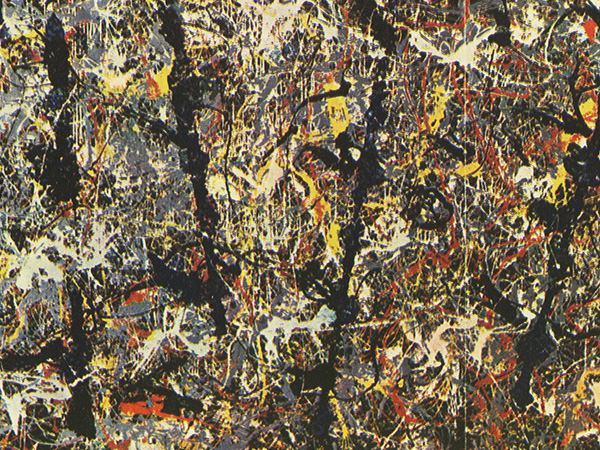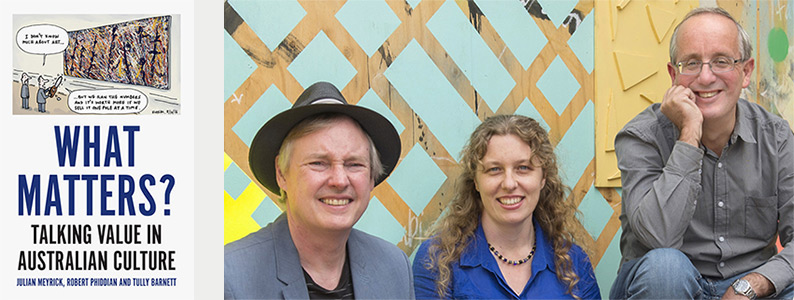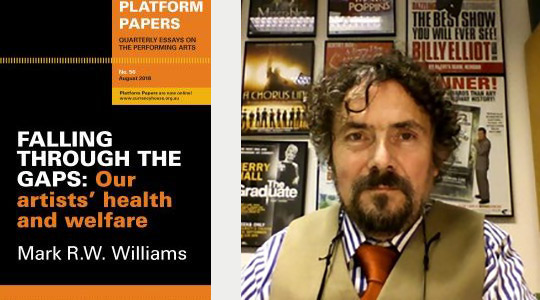Making Art – Episode 07

Questions of Value
Episode Released 7th October 2018
The speed and perceived complexity of life in the modern world appears to be forcing a number of our time honoured clichés into retirement. “A bird in the hand is worth two in the bush” faces an uncertain future in our fast paced world where the idea of spending time catching birds in bushes is looked upon as just plain silly. And “Too many cooks spoil the broth” is teetering on the brink of extinction in the face of Uber Eats, prepackaged dinners and a generation of people who look at you with an expression that says “What is a broth anyway? In the creative world of course we like to think we have the greatest of all the clichés, the dog eared and dusty “Art mirrors life”.
But beyond the apparent glibness of that particular phrase there lies, as there does with stitches and time, a number of simple truths. For example it is true to say that when we read a book, look at a picture, watch a play or listen to a piece of music from a particular period we can be, if we choose, transported to that certain time and begin to understand, in a profoundly nuanced way, something of the politics, ideas and social climate that led to its creation. In this way the art in question becomes the mirror through which we gain a wonderfully complex and deeply human insight into the lives of those in our past.
Ray Lawler’s great Australian play The Summer of the Seventeenth Doll is a classic example. When it was premiered by the Melbourne Theatre Company in 1955 it offered up, for the first time, a theatrical work that was unashamedly Australian. A play that was not only spoken in the Australian vernacular but one that was set in an Australian city in a house populated by Australian people. Not clichés but everyday Australians as we were.
Prior to The Doll, as it has become affectionately known, Australian plays had largely tended toward the fraudulently British. Strained drawing room comedies or genial, bucolic clunkers that were apologetically small in scope. Plays to be tolerated, curiosities, inferior copies of “real theatre” which came principally from Britain.
Lawler’s play represents a seismic shift in Australian theatre that was an expression of, or perhaps a precursor to, a seismic shift in Australian identity. Rather than display a continued acceptance of the notion that we were just British people living a long way from home, Lawler put Australia on stage, not just in the language but also in the exploration of big themes that reflected the reality of an endemically Australian life, ideas that were closer in scope and energy to those explored by Tennessee Williams than they were to reproduction English farce.
What The Doll reflected was a dramatic change in the way we were coming to see ourselves, a theatrical expression of the birth of a people, an artistic mirror in which we can observe our forebears coming to terms with the notion that they were no longer deferential inhabitants of a far flung British dominion but instead an independent people living in an different nation with thoughts and ideas about themselves that were their own. And that the play was a critical and box office triumph attests to a growing confidence amongst Australians to take hold of those ideas and publically express them.
Born out of a connected relationship between a group of artists and the society they inhabited, The Doll was a fundamental part of a national conversation that resulted in massive social change that saw Australia and Australians define and pursue a very particular cultural imagining for themselves that by the mid 1970’s had become a vibrant reality.
Cut to contemporary Australia where for many years we have been in the thrall of an ideology that has had a reductive effect on public discourse. No longer do we talk in big ideas about who or what we are, of nationhood or where we are heading as a people, of hopes and dreams or collective values. We simply talk about money. Complex decisions about our futures are no longer the subject of intelligent, patient and incisive discussion but reduced to packaged pronouncements about how much it costs, its economic impact and its trickle-down effect. As if by some magic trick we now live in a society where we are actually willing to seriously engage in discussions about cutting channels in the Great Barrier Reef and frame those discussions purely in economic terms.
This obsession with economic impact and the idea that the measurement of GDP is the only way we can collectively decide whether life is going well or not has had serious implications for a word that only 30 years ago was something to be discriminated, a term that was the subject of profoundly individual critical judgement. Value. Historically multidimensional, the word value once conjured up an entire universe of thoughts, feelings and meanings but alas over the past so many years value it has been stripped of its linguistic richness to the point where in public discourse it speaks of only one thing. Money. And while certain industries and individuals seem comfortable with this reductive language, for the cultural sector and our creatives it has presented a problem when it comes to simply talking about and doing what we do.
This is because in practice art and culture are not principally products or services but instead a series of complex relationships that result in an experience that speaks to who we are, an experience that in turn becomes a part of a conversation about who we want to be. And while it may be publically presented and money is a part of the exchange, the actual transaction is, at the end point, deeply personal, symbolic and individually received and so almost impossible to quantify. An art may affect us deeply or not at all. It may have currency in our life or it may not. It may live to inform us today, in 40 years or never. We may not see it ourselves but feel its effects as a result of someone else seeing it. It is capricious, mercurial, reflective and above all relational and so to attempt to ascribe a singular monetary value to arts or culture is akin to asking what price you want to put on your girlfriend or a sunny day.
Yet this reductive concept of value has dominated our national conversations for the best part of 30 years and has resulted in cultural policy that is fanatically obsessed with metrics, of finding ways of proving the economic value or otherwise of art and culture as if they were paperweights, ways of measuring what is largely a qualitative experience in purely quantitative terms. Regardless of the difficulty in doing so. A difficulty that didn’t escape our politicians notice at a recent meeting of the Australian Council of Cultural Ministers.
“Although cultural and creative industries are increasingly acknowledged as important components and drivers of growth in the modern, knowledge-based economy, it is difficult to determine their true economic value. The breadth and complexity of the creative industries make them challenging to define and measure—more so than many other industries which are more neatly characterised.”
Despite acknowledging the importance of arts and culture as central to the broader question of knowledge and an admission that the arts and culture are complex, rather than accept that complexity our policy makers seem compelled to revert to the “difficult” question of economic value as if it is some sacred nut to crack, as if complexity was a quality that shouldn’t be celebrated but rather extinguished. Meaning and richness has given way to mathematics and as a consequence what was once a balanced conversation that centered on why has become one purely focused on how much. The benefits of arts and culture, once an accepted social good and fundamental aspect of our humanity are now the subject of vain attempts to value it solely in terms of market reach and beds occupied.
And so if we were to hold a mirror up to our creative industries we would see something that reflects this shoddy thinking. At the high end the scene is dominated, much like our politics, by flabby populism and the repackaging of old ideas presented as new, old ideas without connection to anything other than box office KPI’s. And amongst the less fortunate independent artists, we see long hours and a return to the gift economy while all the while artists are encouraged to soldier on by hollow statements from politicians who talk endlessly about the value of art and artists and how well the sector is performing using rubbery numbers without any concept of what they mean. Statements and policy that once led Dr Julian Meyrick to surmise that Australia was “not a country of second-rate art but of second-rate ideas about art”.
And so it is with some relief that over the past month there have been two quiet, thoughtful and important interventions into the debate about the public value of arts and culture and while neither are showy in the way that much of contemporary public discourse feels it needs to be in order to attract attention, both appreciate that systemic failures of social policy are not the subject of quick fixes but rather considered conversation.
What Matters – Talking Value in Australian Culture invites a discussion about the very idea of what we mean when we speak of value and attempts to reframe the debate around the public value of arts and culture in modern Australia.
Thankfully What Matters does not present another system of indicators for measuring ‘vibrancy’ or ‘quality’. Nor does it blindly and savagely demand a throwing out the baby with the bathwater, an approach to cultural policy that is so often the way of government. Instead, it reframes the conversation we should be having around arts and culture by re-acquainting us with the idea of what it is, an experience, and the meaning of value as it pertains to that experience.
Yes, there are economic benefits to be had in arts and culture although even that statement seems somewhat absurd. But economics are just a part of a richer story of value that has been largely forgotten in our metric obsessed world. What Matters is a straightforward and compelling provocation to engage in a better conversation about art and culture and central to its message is a call for a return to meaning because as the authors point out, unlike automobiles or air conditioners, when it comes to arts and culture no meaning means no value. It is an invitation to exchange nuanced views that go beyond the political cycle, a conversation that requires a collective thoughtfulness and discipline rather than yet another second rate attempt to count what we are unwilling to understand. To understand the why so we can begin to figure out how much.
And if you would like to know what happens when you marginalize a community like the arts community with bullshit statements, submission forms, acquittal procedures, classification systems, priority lists designed, it would seem, only to put a barrier between artists and arts practice or you just summarily decide that you simply don’t need them then perhaps take a look at Dr Mark Williams Platform Paper Falling Through the Gaps – Our Artists’ Health and Welfare.
Australia’s performing artists are ageing and facing increasing poverty, poor health, homelessness and depression, with attempted suicide rates more than double the general population. And I know this to be true from personal experience. Our public obsession with metrics and KPI’s has seen Australia’s performing arts organisations transformed in the past 40 years from ensembles of artists to ensembles of administrators. The mid-range of creative practice across all disciplines has been eviscerated as politicians have gone in search of cultural trickle down with now over 75% of arts funding in this country directed at a but a handful of organisations.
Yet this forced restructure of the artist’s workplace has not come with compensation as it has done in other areas of the Australian economy that have undergone profound change. In Falling Through The Gaps Mark Williams, a prominent arts & entertainment lawyer, argues that as employment rates have fallen dramatically and by assuming a purely monetary rationalism as the motive for all Australians, many of our finest artists are facing old age with little or no financial or community resources. And government services such as Centrelink actively discriminate against those in specialised creative vocations who devote their lives to perfecting their craft by denying recognition of the skills developed over an artist’s lifetime, often refusing support.
What Mark’s paper gives us is a narrative that makes it clear that metrics paint only part of any picture. While the numbers around cultural industries may look good, the lives of our creatives are anything but. And it is easy to think as a member of the public that if you pay $80 to see a show at one of our State Theatre Companies that the actors are doing well but don’t be misled. On any given night if you are sitting in a theatre of 600 people at the STC from the stage we may well be looking at $50,000 worth of tickets but if there are 6 of us in the show you are probably looking at just $1,500 worth of actors. Actors who like all artists live in a gig economy that continues to shrink as our culture, the relationships we have with the ideas of who we are, get placed on an increasingly commercial footing.
The choice to commit one’s self to a life of creativity is undeniably a complex and precarious one. You may well ask, “Why bother?” Well we do it because we must. And when we talk about the value of art and culture or engage in yet another round of debates around questions of why we should support our artists perhaps we should, as Hannah Bertram, artist and lecturer in Visual Arts suggested recently when she opened the 2018 Graduate Exhibition at Deakin University, “try to imagine a world without them”. “What would the world look like without books, film, theatre, songs, architecture, fashion, painting or sculpture?” No Eifel Tower or Sydney Opera House, no Harry Potter or Hollywood, no Monet’s Water Lilies or Fred Williams You Yangs. No wonder, no richness, curiosity, colour or beauty. Nowhere to share our stories. No mirror to our lives but instead a world of snappy statements and slippery numbers. It’s not the kind of world I want to live in.

What Matters – Talking Value in Australian Culture by Dr. Julian Meyrick, Dr. Tully Barnett and Professor Robert Phidian is published by Monash University Press

Falling Through the Gaps – Our Artists’ Health and Welfare by Dr Mark Williams is published by Currency Press

